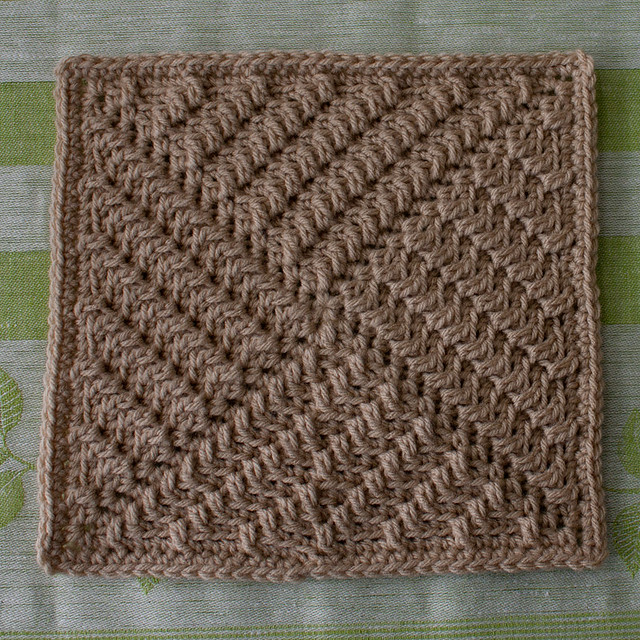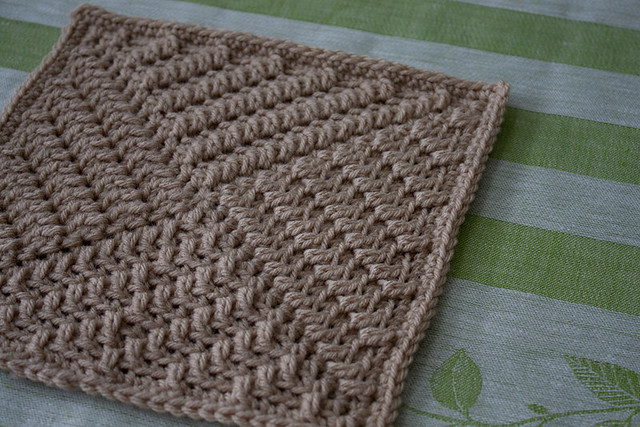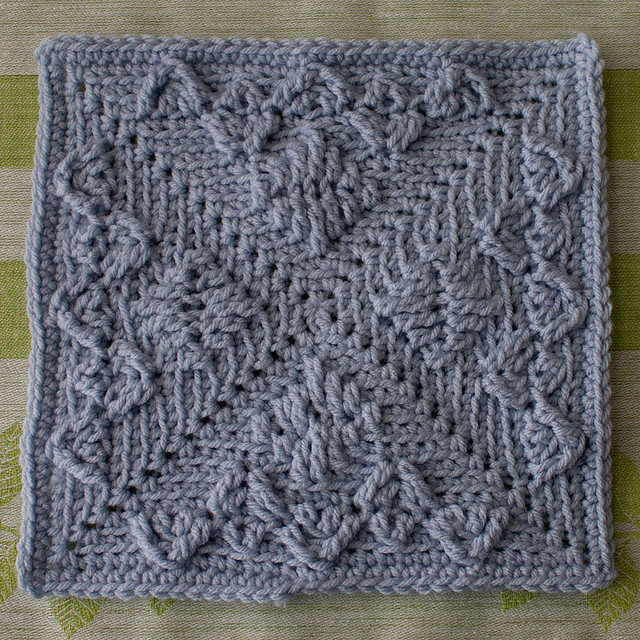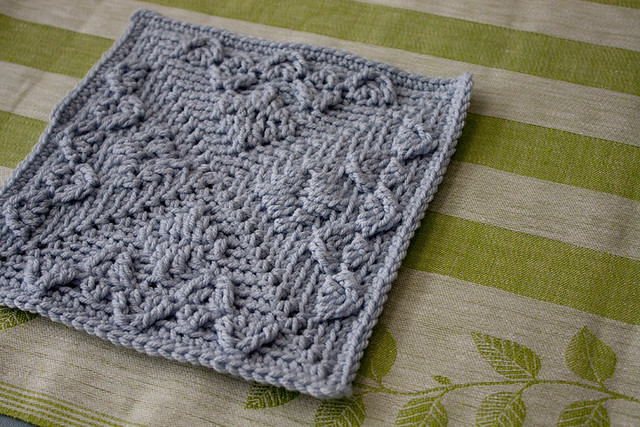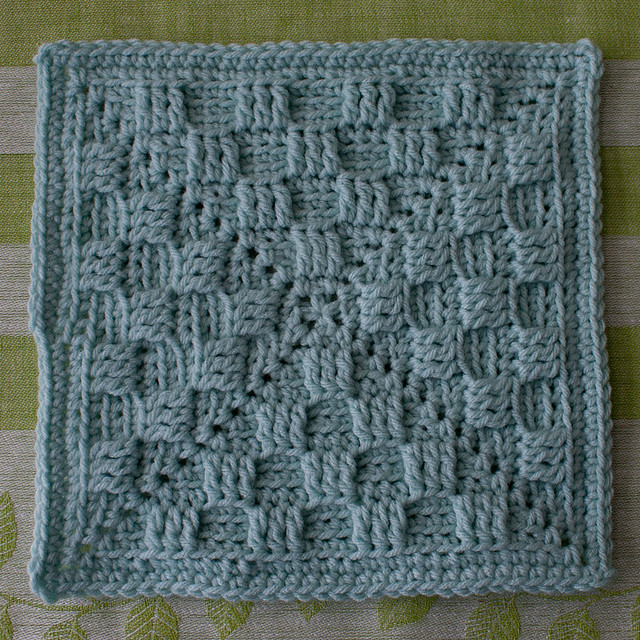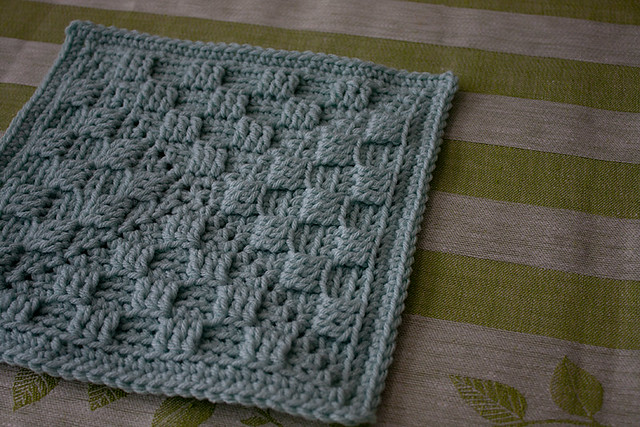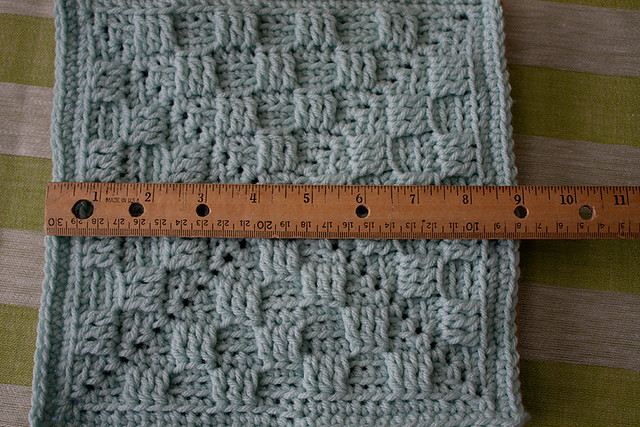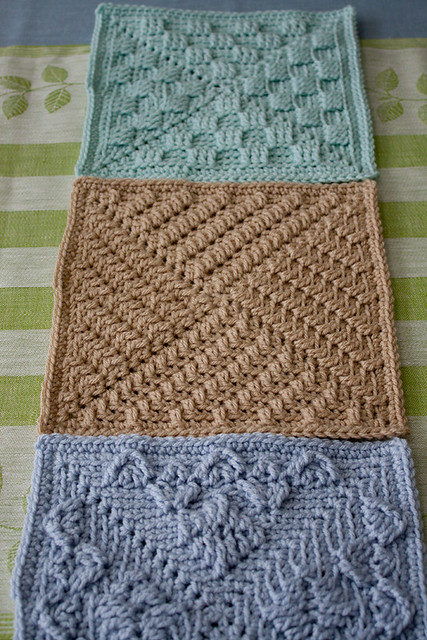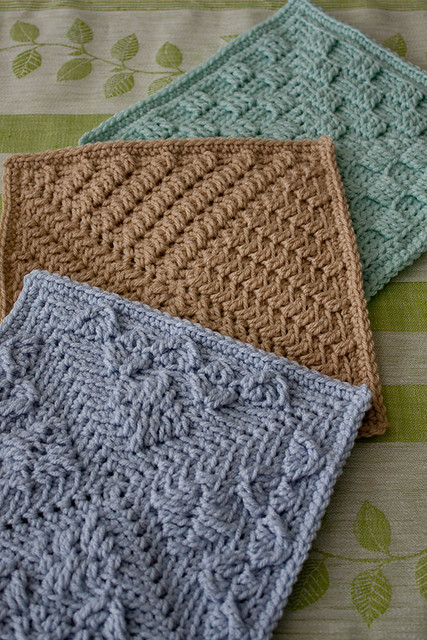I've finished the first three blocks for the Stardust Melodies CAL (which I mentioned in a recent blog post).
These are smaller than the typical 12" blocks (mine in heavy worsted/aran are coming out as about 9" squares), and they are one color each, so they work up fairly quickly. Since Polly's releasing a new pattern twice a week (Mondays and Thursdays, I believe), this CAL won't last all that long. (It ends August 17th.)
I'll try my best to keep up, but I haven't yet decided how big I want my afghan to be, and I'll likely want to make multiples of at least some of the blocks to "size up" the finished blanket, so even if I do keep up, I may not be finishing my afghan immediately after the CAL wrap-up. There's no hurry, of course, but I do want to finish this project in a reasonable time frame. No more hibernating projects, please!
So, the first few blocks!
A lot of participants are changing up the patterns slightly to avoid visible seams. (They're not extremely visible, as it is, but we all have our pet peeves, and it appears that many of us will go out of our way to eliminate even a slight seam.) There are at least a couple of ways to do that. Some people are adjusting the patterns so that each round begins/ends in a corner, where seams are more easily disguised. (There are instructions for corner joins in the CAL introduction PDF you get if you purchase the ebook.)
Others are working the blocks in a spiral. Basically, instead of slip-stitching to join and chaining up for the next round, you just work the first stitch of the next round directly into the first stitch of the last round.
I've used the spiral method for all three blocks, so far, and I've found that it's a must to use a stitch marker to keep track of that first stitch. Be sure to move it up as you go! Otherwise, it gets very confusing.
My blocks all have a slight "blip" where the final round is joined, because they were worked in a spiral. I feel confident that this will even out once the blocks have been joined and laundered, but it is visible in my photos. I don't pre-block afghan squares, so they're just gently pulled into shape, for the time being.
I've hardly had to look at the patterns at all, in these first three blocks, because I've followed along with Polly's detailed video tutorials. They've been a great alternative to the written directions and the charts. I highly recommend them, if you learn well from watching a demonstration or listening to instructions. I've even picked up one or two little tricks that will serve me well beyond this CAL.
"Begin the Beguine"
Once you get into the groove of this one, it's simple enough (and enjoyable to crochet). It looks more complicated than it is. Really interesting texture. (Prepare to see that a lot in these CAL progress reports, considering that they're all all about the texture. (g))
"Fools Rush In"
This is the first of the paid patterns. (Remember, half are free and half only come with the ebook. Freebies are published on Mondays; paid patterns come out on Thursdays.)
This one was somewhat more advanced-- as you might expect. I had fun making it, but you do have to pay more attention than with the free blocks, which are more of a solid, all-over pattern. Working this one in a spiral kind of slightly "mussed" the dimensional diamond on that side of the block, but it's not too bad. If I make this one again, I might try a corner join, instead, to see if I prefer the results with that method, but I'm not bothered enough to rip this one out. It'll be fine in a blanket!
"Don't Fence Me In"
I've never been particularly drawn to basket-weave/checkerboard crochet patterns (or entrelac, for that matter)-- but I like this pattern more than I would have expected. It was very easy, once in the rhythm, and the texture really jumps out at you. Very strong 3-D effect with this one!
I'm surprised that my blocks are turning out to be 9", because I think that's what they're "supposed" to be, and my crochet blocks generally turn out to be smaller than they're "supposed" to be. Of course, it doesn't really matter how big/small they are, so long as all the blocks for the same afghan are close to the same size-- and they are! (~cue dancing in the streets~)
I'm even happier to report that they're working out to be about the same size across different brands of yarn. Sometimes mixing brands can cause problems-- especially when each block is worked entirely in one yarn. (At least when you change colors/yarns every few rounds, things have a chance of evening out.) However, though some of the brands I'm using are slightly thicker than others, it doesn't seem to be an issue, so far.
One of this project's idiosyncrasies is that I felt the need to use a larger hook than usual. Typically, I use a 4.0mm or 4.5mm hook with these types of yarns, when I crochet afghan blocks. However, I think the fact that these are all based on single crochet was making the resultant fabric feel tighter than I wanted. I ended up using a 5.5mm hook-- and probably could've gone up even higher, but this will do.
Now I need to figure out how large I want the blanket to be-- how many blocks I'll need-- and if it's more than 24 (the number of patterns in the CAL), which ones I want to repeat.
The next pattern comes out tomorrow, so there's not long to wait!
These are smaller than the typical 12" blocks (mine in heavy worsted/aran are coming out as about 9" squares), and they are one color each, so they work up fairly quickly. Since Polly's releasing a new pattern twice a week (Mondays and Thursdays, I believe), this CAL won't last all that long. (It ends August 17th.)
I'll try my best to keep up, but I haven't yet decided how big I want my afghan to be, and I'll likely want to make multiples of at least some of the blocks to "size up" the finished blanket, so even if I do keep up, I may not be finishing my afghan immediately after the CAL wrap-up. There's no hurry, of course, but I do want to finish this project in a reasonable time frame. No more hibernating projects, please!
So, the first few blocks!
A lot of participants are changing up the patterns slightly to avoid visible seams. (They're not extremely visible, as it is, but we all have our pet peeves, and it appears that many of us will go out of our way to eliminate even a slight seam.) There are at least a couple of ways to do that. Some people are adjusting the patterns so that each round begins/ends in a corner, where seams are more easily disguised. (There are instructions for corner joins in the CAL introduction PDF you get if you purchase the ebook.)
Others are working the blocks in a spiral. Basically, instead of slip-stitching to join and chaining up for the next round, you just work the first stitch of the next round directly into the first stitch of the last round.
I've used the spiral method for all three blocks, so far, and I've found that it's a must to use a stitch marker to keep track of that first stitch. Be sure to move it up as you go! Otherwise, it gets very confusing.
My blocks all have a slight "blip" where the final round is joined, because they were worked in a spiral. I feel confident that this will even out once the blocks have been joined and laundered, but it is visible in my photos. I don't pre-block afghan squares, so they're just gently pulled into shape, for the time being.
I've hardly had to look at the patterns at all, in these first three blocks, because I've followed along with Polly's detailed video tutorials. They've been a great alternative to the written directions and the charts. I highly recommend them, if you learn well from watching a demonstration or listening to instructions. I've even picked up one or two little tricks that will serve me well beyond this CAL.
"Begin the Beguine"
Once you get into the groove of this one, it's simple enough (and enjoyable to crochet). It looks more complicated than it is. Really interesting texture. (Prepare to see that a lot in these CAL progress reports, considering that they're all all about the texture. (g))
"Fools Rush In"
This is the first of the paid patterns. (Remember, half are free and half only come with the ebook. Freebies are published on Mondays; paid patterns come out on Thursdays.)
This one was somewhat more advanced-- as you might expect. I had fun making it, but you do have to pay more attention than with the free blocks, which are more of a solid, all-over pattern. Working this one in a spiral kind of slightly "mussed" the dimensional diamond on that side of the block, but it's not too bad. If I make this one again, I might try a corner join, instead, to see if I prefer the results with that method, but I'm not bothered enough to rip this one out. It'll be fine in a blanket!
"Don't Fence Me In"
I've never been particularly drawn to basket-weave/checkerboard crochet patterns (or entrelac, for that matter)-- but I like this pattern more than I would have expected. It was very easy, once in the rhythm, and the texture really jumps out at you. Very strong 3-D effect with this one!
I'm surprised that my blocks are turning out to be 9", because I think that's what they're "supposed" to be, and my crochet blocks generally turn out to be smaller than they're "supposed" to be. Of course, it doesn't really matter how big/small they are, so long as all the blocks for the same afghan are close to the same size-- and they are! (~cue dancing in the streets~)
I'm even happier to report that they're working out to be about the same size across different brands of yarn. Sometimes mixing brands can cause problems-- especially when each block is worked entirely in one yarn. (At least when you change colors/yarns every few rounds, things have a chance of evening out.) However, though some of the brands I'm using are slightly thicker than others, it doesn't seem to be an issue, so far.
One of this project's idiosyncrasies is that I felt the need to use a larger hook than usual. Typically, I use a 4.0mm or 4.5mm hook with these types of yarns, when I crochet afghan blocks. However, I think the fact that these are all based on single crochet was making the resultant fabric feel tighter than I wanted. I ended up using a 5.5mm hook-- and probably could've gone up even higher, but this will do.
Now I need to figure out how large I want the blanket to be-- how many blocks I'll need-- and if it's more than 24 (the number of patterns in the CAL), which ones I want to repeat.
The next pattern comes out tomorrow, so there's not long to wait!
